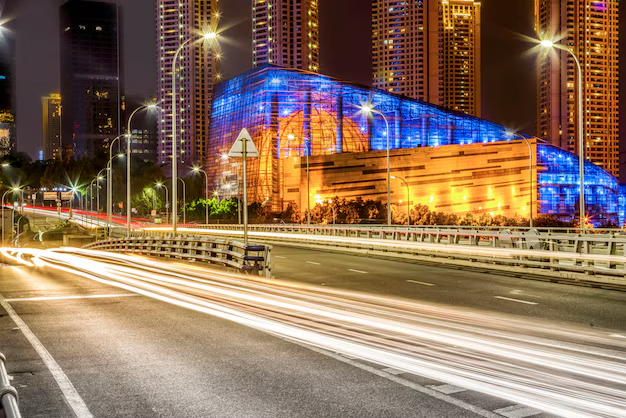Tunnel lighting has undergone a major transformation in recent years, shifting from outdated and inefficient lighting systems to advanced LED tunnel lights. These innovative lighting solutions are now the cornerstone of tunnel safety, efficiency, and sustainability. From highways to metro railways, LED tunnel lights offer superior illumination, energy savings, and visual comfort, meeting the stringent requirements of modern infrastructure.
In this comprehensive guide, we explore every facet of LED tunnel lights — from their structure and types to lighting standards, installation practices, and how to choose high-quality units. Whether you’re involved in road construction, lighting design, or facility management, this article will serve as your complete resource.
| Tunnel Section | Wattage Range | Common Wattage Used | Recommended Spacing |
|---|---|---|---|
| Entrance | 100W–300W | 100W, 150W, 200W | 1–1.5 meters |
| Transition Section | 70W–120W | 100W | 2–3 meters |
| Middle Section | 30W–60W | 50W | 8–12 meters |
| Exit Section | 100W–300W | 100W, 150W, 200W | 1–1.5 meters |
| Emergency Lighting | 30W–60W | 50W | 25 meters |
Tunnel lighting has evolved significantly over the decades. Traditional systems, including high-pressure sodium (HPS), metal halide (MH), and fluorescent lamps, were widely used in road and rail tunnels. However, these technologies were plagued by high energy consumption, frequent maintenance, short lifespan, and inflexible illumination control.
The advent of LED (Light Emitting Diode) technology introduced a turning point. LED tunnel lights not only consume less energy but also offer exceptional durability, longer life spans, better light quality, and instant on-off capabilities. These benefits make LEDs the go-to option for tunnel projects around the world.
LED tunnel lights are engineered with precision to withstand harsh environments, resist vibration, and offer consistent performance. Their robust structure typically includes the following key components:
Lamp Body: Usually constructed from die-cast or extruded aluminum alloy, the lamp body ensures heat dissipation and structural integrity. Thicker, heavier bodies generally indicate better durability.
Heatsink: Integrated or finned heatsinks enhance thermal management. The larger the surface area, the better the heat dissipation, which leads to lower light decay and extended lifespan.
Light Source: High-power LEDs or SMD LED chips are used depending on the application. A module often includes 50–60 LED chips, totaling about 50W per unit. LED quality determines brightness, CRI, and reliability.
Driver: High-quality drivers from brands like Mean Well or Inventronics ensure constant current, flicker-free lighting, and long-term performance. Look for features like aluminum housing, full potting, and high power factor.
Mounting Bracket: Typically U-shaped and made of stainless steel or thick aluminum. Adjustable for various angles, the bracket’s sturdiness impacts installation safety.
Light-Emitting Cover: Often made of polycarbonate (PC) with lenses for better light diffusion and protection against environmental hazards.
Connectors and Fasteners: Waterproof plug-and-play connectors simplify installation and future maintenance, while stainless steel fasteners prevent corrosion.
LED tunnel lights come in several variants tailored to different operational needs:
Standard LED Tunnel Lights: These are the most commonly used and provide consistent, non-adjustable illumination.
Dimmable LED Tunnel Lights: Equipped with 0–10V dimming control systems, these lights allow for adaptive lighting based on ambient conditions, traffic flow, and time of day. Dimming can be achieved through positive or inverse logic to maintain lighting even if a controller fails.
Emergency LED Tunnel Lights: Installed to provide backup lighting in case of power failure. These units typically operate for 60 to 120 minutes (standard is 90 minutes) to ensure safe evacuation and hazard mitigation.
Linear Tunnel Lights: These lights offer shadow-free, even lighting over long distances. Ideal for metro, industrial, and automotive tunnels.
Tunnel lighting isn’t just about visibility — it’s also about safety, human psychology, and traffic flow. Various international standards, like CIE and NFPA 50,2, define the principles of effective tunnel illumination:
Entrance Lighting: Compensates for the abrupt change from daylight to the tunnel interior. It includes the threshold zone and the transition zone. Entrance lighting must reduce the “black hole effect” and allow drivers’ eyes to adjust.
Interior Lighting: Provides uniform brightness to ensure continued visual comfort. Light levels are based on speed and traffic density.
Exit Lighting: Similar to the entrance zone, especially for two-way traffic. It ensures a smooth visual transition as drivers re-enter daylight.
Brightness and Uniformity: Tunnels must maintain a balanced brightness ratio across surfaces to prevent glare and visual fatigue. The average-to-minimum brightness ratio must be optimized.
Glare Control: Excessive glare affects driving safety. LED tunnel lights must be angled and diffused properly to minimize direct or reflected glare.
Flicker Reduction: Flicker, caused by light placement and vehicle movement, can be dangerous. Acceptable flicker frequencies range below 2.5Hz or above 15Hz.
Smart Lighting Control: Integrating sensors, controllers, and automation ensures optimal brightness and energy savings under various environmental and traffic conditions.
Proper installation is crucial for the effectiveness and longevity of LED tunnel lighting. Here’s how to plan spacing and wattage:
Height: Most LED tunnel lights are installed at a height of 4 to 6 meters. A typical installation uses a height of 4.5 meters for optimal coverage.
Spacing: Varies according to the tunnel section. Entry and exit zones require closer spacing due to high luminance requirements. The middle section allows for wider spacing, often up to 12 meters.
Emergency Light Placement: Install every 25 meters for effective coverage.
The advantages of LED tunnel lighting go far beyond energy efficiency. They include:
Longevity: LED lights can last up to 100,000 hours, reducing replacement frequency and maintenance costs.
Safety: Uniform and high-quality light improves driver reaction times, reduces accidents, and ensures clear visibility.
Energy Efficiency: Consumes 60–80% less energy than traditional lighting, significantly cutting operating costs.
Customizability: LEDs allow dynamic lighting changes based on weather, time, or traffic flow.
Environmental Sustainability: Lower carbon footprint, recyclable materials, and reduced energy consumption make LEDs eco-friendly.
Low Heat Output: Unlike HID or halogen lights, LEDs emit minimal heat, which prolongs fixture life and improves tunnel safety.

When selecting LED tunnel lights for your project, prioritize quality, reliability, and design features:
Choose reputable brands like Cree, Philips, or Osram for LED chips that offer high luminous efficiency and high CRI.
Opt for drivers from top-tier manufacturers such as Mean Well, Inventronics, or MOSO to ensure performance longevity and safety compliance.
Look for aluminum housing with finned heatsinks to support optimal thermal dissipation.
Use lights with a modular design — multiple smaller modules distribute heat better than a single large one.
Go for plug-and-play waterproof connectors to simplify maintenance.
For tunnels in foggy or low-visibility areas, pick LED lights with a lower color temperature (3000K–4000K) for better penetration.
Prefer reverse dimming options to avoid lighting failure in case of controller issues.
Always request CAD drawings or 3D simulations from the manufacturer to ensure compatibility with your tunnel’s specifications.
LED tunnel lights are not restricted to road tunnels alone. They are widely used in:
Automotive repair shops and detailing garages
Industrial warehouses and manufacturing facilities
Showrooms and car wash tunnels
Stadiums and architectural facades
These applications benefit from the shadow-free, flicker-free, and high-CRI lighting that LED tunnel systems provide. Furthermore, modular lighting structures enable DIY assembly and cost-effective installation, often saving over 60% compared to traditional setups.
LED tunnel lights have become the gold standard in tunnel illumination, offering unmatched efficiency, safety, and performance. From their sophisticated structure and smart control features to their versatile applications, LED tunnel lights are designed for the modern age of infrastructure. By understanding the technical standards, types, and installation requirements, stakeholders can make informed decisions that not only enhance tunnel safety but also reduce long-term costs and environmental impact. With innovations in smart lighting, modular designs, and material science, the future of tunnel lighting is brighter, safer, and smarter — thanks to LEDs.
Green Benefits: Unlocking Value Through Sustainability
Which lights to use in a tunnel?
LED tunnel lights are the ideal choice due to their high energy efficiency, long lifespan, and ability to provide uniform, glare-free illumination. They can be customized for various tunnel zones, ensuring safety and visibility for drivers in both day and night conditions.
Why use aluminum alloy instead of stainless steel for tunnel lights?
Aluminum alloy is preferred for its superior heat dissipation, lighter weight, and corrosion resistance. It is also more cost-effective and easier to shape, making it ideal for manufacturing complex heatsink designs necessary for LED tunnel lights.
How many watts of LED tunnel lights can replace 400W sodium lamps?
Typically, a 100W to 150W high-efficiency LED tunnel light can replace a 400W sodium lamp, depending on the luminous efficacy and optical design. This results in substantial energy savings and better light quality.
What is the tunnel lighting lux level?
Tunnel lighting lux levels vary by zone. For example, entrance zones may require up to 300 lux during the day, while the interior zones typically need 20 to 50 lux. These values ensure safe visual transitions and prevent accidents.
What is the best color temperature for tunnel lighting?
A color temperature of 4000K to 5000K is generally recommended for tunnel lighting. It provides a balance between visibility and visual comfort. In foggy conditions or areas requiring stronger penetration, 3000K may be used for better contrast and clarity.

